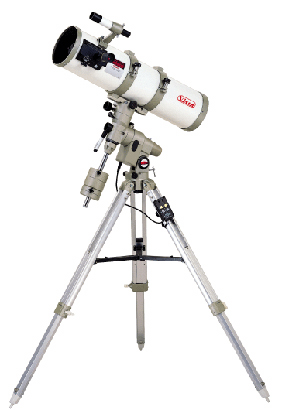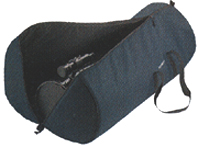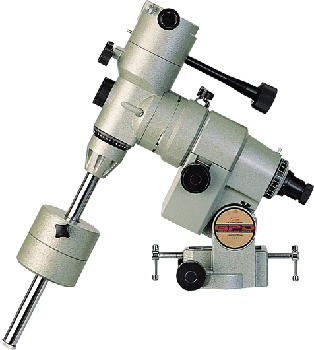Vixen Distribution
![]() History
History ![]() News
News ![]() Notes & Literature
Notes & Literature ![]() Overview
Overview ![]() Pricing
Pricing ![]() Products
Products
![]() Mounts
Mounts
![]() Telescopes
Telescopes
![]() Quality Control
Quality Control
![]() Service or Repair
Service or Repair

VIXEN GREAT POLARIS "GPDX" GERMAN EQUATORIAL MOUNT
"a GP German equatorial mount on steroids..."
Right: Vixen GPDX German equatorial mount head shown as provided with no other accessories (65,529 bytes)
Click on the image to see enlarged view (131,256 bytes).
![]() Overview: What is the GPDX and when do we recommend it?
Overview: What is the GPDX and when do we recommend it?
The GPDX is one of the most massive of the three "Great Polaris" series German equatorial mounts manufactured by Vixen Co., Ltd. The other model GP mounts include the lighter weight GPE model, and another which is similar in appearance to the GPE but is its better accessorized cousin the GP. The GP series are the descendants of the Vixen "Super Polaris" mounts which came to dominate the 1980's. In the USA the Super Polaris were distributed under the Celestron trademark. The heavier duty "Super Polaris DX" was not made available in the USA until 1989 when it was evaluated by Roland Christen, founder of Astro-Physics company who imported it for sale to the USA through both Astro-Physics and Company Seven. The SP-DX was considered a suitable but relatively economical platform for their then new 12cm f8.4 ED doublet Apochromat, and their 4 and 5 Inch f8 Apo telescopes.
The Great Polaris are an improved, modular German equatorial mount system where the customer is allowed to tailor the system to their particular needs choosing from a broad selection of accessories. The GP-DX mount closely resembles the more compact and portable GP mount however, this belies it's notably superior payload handling and tracking. The GP-DX differences include durable steel is used for the R.A. and Declination Axes shafts, the worm wheels are made of brass (to about double the tolerance of the GP) on improved bearings to provide smooth and stable operation. Accordingly, the GP-DX mount head weighs almost twice as much as the GP.
alignment to within 3 minute accuracy possible, bubble-level, fine adjustment knobs for both altitude and azimuth, and one 8 lb / 3. kg counterweight are provided. Refinements include a Dovetail Plate hardware mechanism to facilitate the quick interchange of payloads, a better selection of tripods and electronic drive systems.
Company Seven recommends the GPDX to accommodate payloads including:
- cameras for wide sky astrophotography or sky survey applications,
- telescopes weighing up to about 22 lb. / 10 kg, this can include
- Refracting telescopes up to about 130 mm aperture *
- Reflecting telescopes up to about 250 mm *
- Catadioptric telescopes of up to about 230 mm *
* there are factors acting upon a German mount affecting its suitability including: payload weight and length (torque), payload area and profile exposed to winds, desired tracking accuracy, tripod or pier resonance's, etc. What are most important to the user is how rigidly the mount holds the payload, how smoothly it tracks (amplitude and smoothness of the periodic error of a gear), and how well it overcomes the moment imparted by the load. The final operating weight put onto a mount can also depend on how the instrument is to be accessorized.
If you wish to buy a most economical, and relatively light weight refined mount that can manage your payload for manual visual operations, or for simple driven uses then the GPDX can make sense. The GPDX can provide a lifetime of service, and it is deserved by many better quality telescopes including the Astro-Physics 105 'Traveler' or 130 mm f6 EDF, or the TeleVue NP101 and 102 or 127, etc. where the cost of the GPDX can be readily justified. And the choices of simple electronic drive systems are better for the GPDX than those available for most other mounts at or below the cost of the GPDX mounts. But when one gets to the point of buying a complete new GPDX delivered with dual axis drive controller, two motors, two clutches, etc. then the cost climbs into the realm of superior alternatives.
For those who observe from wind prone locations, or for those who intend to become involved in longer time exposure astrophotography or CCD imaging then we suggest you consider one of the following mounts because of their more sophisticated electronics, and even better weight bearing and tracking performance:
The GPDX mount is available as a Mount Head with Quick Release Saddle including Counterweight Shaft,
Below Right: A complete Vixen
A complete GPE mount system will usually consist of these components:
Company Seven offers a number of third party accessories for the GP/GPDX mounts. These include Digital Setting Circle with Encoder sets, or optional fitted Carrying Bag (sample shown at right) which can provide for safer, and more convenient transport the mount with tripod attached, or one for the Tripod alone. Please understand that these are very convenient and padded lightweight bags however, these are not suitable for shipping a telescope or mount. Company Seven do offer rather costly buy sometimes necessary Airline Transport Association approved shipping cases for these products which are suitable for check in on aircraft, or shipping by common carriers.
Please visit Company Seven's showroom to see examples of these Vixen systems firsthand. Or you may Contact Company Seven for help putting together a system for you.
Vixen GPE Optional SD-1 Electronic Drive Specifications
Vixen GPE Optional DD-1 Electronic Drive Specifications
* may exceed range of some batteries
Specifications and availability subject to change
The SD-1 Drive Controller for the GPE/GPDX mounts operates from 9 volt DC power sources, it is provided with a cluster battery holder for six alkaline "C" cell batteries, and power cord. For convenience it is probably best to keep feeding the SD-1 the provided battery pack as it needs them. For operations in below freezing conditions then we recommend you keep the battery pack for the SD-1 in a warm area, possibly in a coat pocket when working near the telescope. Otherwise you may use more costly lithium batteries which perform better at lower temperatures.
The DD-1 Drive Controller for the GPE/GPDX mounts is provided with a cluster battery holder for eight alkaline "D" cell batteries, and power cord. The DD-1 and other common telescope powered accessories (Kendrick Dew/Frost Prevention System, CCD cameras, etc.) require a 12 volt D.C. power source. If you prefer a longer life or more cost effective power supply then Company Seven suggests the user consider one of these following options:
with optional 1.9 kg counterweights, DS-1 Single Axis Drive, HAL110 Aluminum Field Tripod (39,881 bytes).
Click on image to see enlarged view (164,592 bytes)

Single Axis:
Dual Axis:

![]() GPE Features and Specifications
GPE Features and Specifications
Vixen GPE Mount Head Specifications
Right Ascension Setting Circle - 10 Minute increments
Declination Setting Circle - 2 Degree increments
![]() Drive System Power Requirements, Sources
Drive System Power Requirements, Sources
Contents Copyright 1994-2004 Company Seven All Rights Reserved



